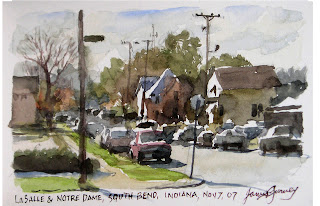1. Title it something. "Untitled" is a title. It's fine if you have one painting called "Untitled," but it's a headache for art historians or grandchildren who have to agree whether to call them Untitled 1, Untitled 2, etc. Above are some of the images that come up when you search for Picasso's untitled paintings.
2. Title everything you do, if for no other reason than so you can find it again on your computer. Come up with a regime for titling minor works, so that, for example, "Dead Neon.PA.jpg" means the plein air sketch of the neon sign, while "Dead Neon.LO.jpg" is the preliminary layout.
3. Write the title on the work. Write it as soon as you know it at the edge of a drawing, on the back of the illustration board, or on the stretcher bar of the painting. Also write the title in a database that you can find easily. That way if it comes up for auction someday, you piece won't be forced to live under a dishwater-dull descriptive title such as "Man Kneeling before Blonde Woman."
4. Let the file name reflect the variants. My system is to use caps for a big file shot by a professional photographer, such as "DESERT_CROSSING.JPG". If it's a large file I shot myself with my good camera, I call it "Desert_Crossing.LG.jpg." If I shot it with my so-so camera, I call it "Desert_Crossing.lg.jpg." If I have vignetted it to white in Photoshop, I call it "Desert_Crossing.LG.WT.jpg," etc.
5. Avoid articles, such as "The" and "An." This is simply because you can find it easier in an alphabetized computer folder. "Ferry Crossing" works just as well as "The Ferry Crossing," and it's filed under "F."
7. Sometimes you may want multiple names. For example, if I paint a cover for a paperback book and the book title does not suit the painting, I rename the painting. So the cover painting for "Michaelmas" I know as "Hologram." Still, both names will always chase that painting.
8. Make sure you recognize the piece from the title. I try to use a title that is my mental shorthand for the piece, and I try to keep it as short as possible. That's why I don't use poetic titles. I called one painting "Last Gift of the Sun," and I can never remember which of the sunset paintings that was.

9. If in doubt, just be specific. If it's a plein air study of a street scene, I like to use the street names, such as "LaSalle and Notre Dame." If it's a sketchbook study and there are written notes beneath the image, make those notes into the title. Richard Estes titled his paintings with a random word that appeared inside the image. Plein air painters may want to tie the image to the date or the GPS coordinates.
10. If you run out of ideas, consider letting your friends or your spouse come up with titles. Betsy Wyeth came up with many of Andrew Wyeth's great titles. Blog reader Diana said, "A friend of mine took one look at a new landscape of mine and exclaimed "OMG Alice in Wonderland Goes Farming." I used the title, and it sold within 24 hours of being hung. I will always wonder if the title wasn't hugely responsible for the sale..."
------
Merry Christmas, everybody!
-------
Previously on GJ:
Titles for Paintins, Part 1
Titles for Paintings, Part 2







